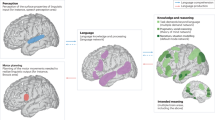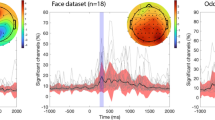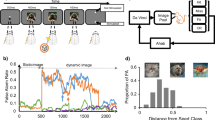Abstract
How long does it take for the human visual system to process a complex natural image? Subjectively, recognition of familiar objects and scenes appears to be virtually instantaneous, but measuring this processing time experimentally has proved difficult. Behavioural measures such as reaction times can be used1, but these include not only visual processing but also the time required for response execution. However, event-related potentials (ERPs) can sometimes reveal signs of neural processing well before the motor output2. Here we use a go/no-go categorization task in which subjects have to decide whether a previously unseen photograph, flashed on for just 20 ms, contains an animal. ERP analysis revealed a frontal negativity specific to no-go trials that develops roughly 150 ms after stimulus onset. We conclude that the visual processing needed to perform this highly demanding task can be achieved in under 150 ms.
This is a preview of subscription content, access via your institution
Access options
Subscribe to this journal
Receive 51 print issues and online access
$199.00 per year
only $3.90 per issue
Buy this article
- Purchase on Springer Link
- Instant access to full article PDF
Prices may be subject to local taxes which are calculated during checkout
Similar content being viewed by others
Author information
Authors and Affiliations
Rights and permissions
About this article
Cite this article
Thorpe, S., Fize, D. & Marlot, C. Speed of processing in the human visual system. Nature 381, 520–522 (1996). https://doi.org/10.1038/381520a0
Received:
Accepted:
Issue Date:
DOI: https://doi.org/10.1038/381520a0
This article is cited by
-
Modulating the difficulty of a visual oddball-like task and P3m amplitude
Scientific Reports (2024)
-
Visual features are processed before navigational affordances in the human brain
Scientific Reports (2024)
-
The role of recognizability in modulating scene consistency effect
Current Psychology (2024)
-
Multiple expressions of “expert” abnormality gist in novices following perceptual learning
Cognitive Research: Principles and Implications (2023)
-
A novel videoscope and tool kit for percutaneous pericardial access under direct visualization
BioMedical Engineering OnLine (2023)
Comments
By submitting a comment you agree to abide by our Terms and Community Guidelines. If you find something abusive or that does not comply with our terms or guidelines please flag it as inappropriate.



